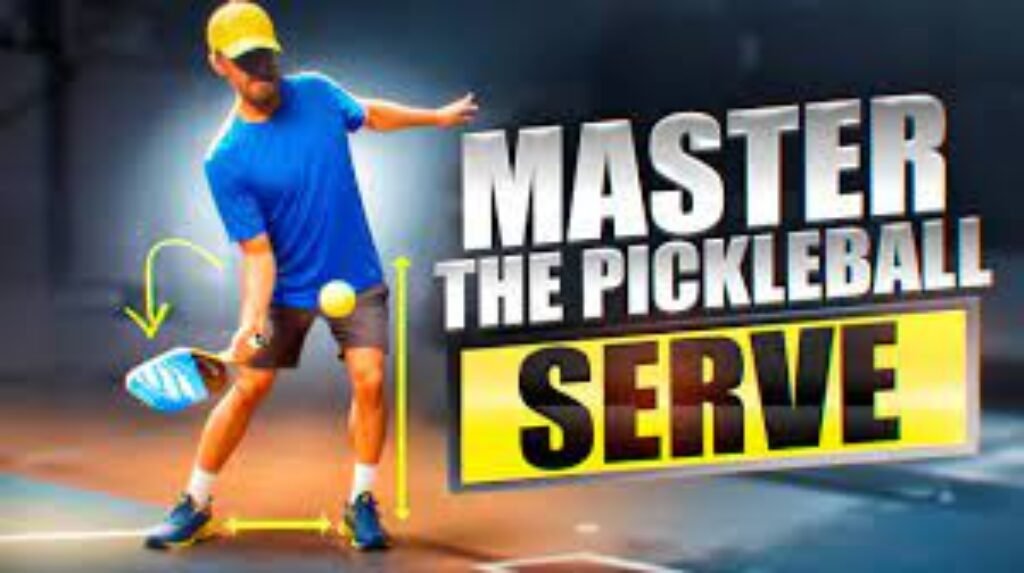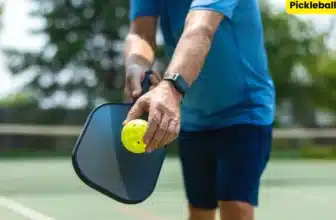
Whatever your experience level in the game, knowing the importance of pickleball is essential for everyone! From those subtle spins to the power-packed drives, basic knowledge of the serving rules and techniques adds much-needed finesse to your game.
So, here we are, about to explore the mechanics, strategies, techniques, and tips of pickleball serves that make them a key player in your winning playbook. Ready to dive in? Let’s get started!
Understanding the Basics About First Serves
A good Pickleball player should be familiar with the fundamentals, including court position, serving, and scoring. As a result, you’ll be able to play with greater assurance and less error. Having this knowledge makes playing the game more enjoyable. After you understand the rules, pickleball becomes a lot of fun. Pickleball is a fascinating and unique sport since its rules are based on badminton, tennis, and ping-pong. They also allow you to win more points. Pickleball is more fun and rewarding when you know the rules, whether you are just starting or want to participate.
Serving Essentials

In pickleball, every point kicks off with the serve. The golden rule is simple: you can only score when it’s your turn to serve. No matter how epic the rally or skilled your play is, points are exclusively scored during your serving turn.
Now, let’s break down the six key pickleball serving rules:
1. Underhand or Backhand Motion
- Your serve pickleball must have an underhand or backhand motion. This means that the arm of the server has to move in an upward arc when the ball is struck. You can’t hit from above or the side.
2. Contact Point Below the Waist
- The point where the paddle meets the ball must be below your waist.
3. Paddle Head Below Wrist
- The paddle head must stay below the highest part of your wrist during contact, emphasizing the upward arc motion.
4. Diagonal Opposite Service Area
- The serve must land diagonally across the court in the opponent’s service area, similar to tennis.
5. Correct Foot Placement
- Ensure at least one foot is touching the playing surface behind the baseline when you hit the ball. Keep your feet within the imaginary extension of the sideline and centerline.
6. One Serve Attempt
- Unlike tennis, you only get one serve attempt. If you are at fault, the serve goes to your partner, or the other team gets a side out.
Pickleball Serve Techniques
There are two types of pickleball serves: the traditional volley serve and the drop serve.
- Volley Serve
Hit the ball before it touches the ground. This benefits from speed and power and is ideal for experienced players.
- Drop Serve
Drop the ball (from any height) and strike it after it bounces on the ground. Introduced in 2022, this serve is beginner-friendly, allowing for easier success and spin.
Pros and Cons
Pickleball Volley Serve:
Pros:
- Speed and Power: Delivers a forceful shot with impressive speed.
- Maximum Impact: Striking the ball just below the navel ensures a high impact point.
Cons:
- Limited Height: The power-packed serve may result in a higher bounce.
- Risk of Overhit: There’s a potential to hit the ball too high and long.
Pickleball Drop Serve:
Pros:
- Spin Advantage: Ideal for adding spin to your serve, creating unpredictability.
- Low Contact Point: A lower bounce height, making it challenging for opponents to respond.
Cons:
- Reduced Power: Lacks the sheer power associated with the traditional volley serve.
- Height Limitation: The drop serve rarely produces a bounce higher than mid-thigh.
Serving Sequence
Now, let’s talk about how pickleball serving works – it is like following a set order that keeps everything organized.
Before you start serving, you need to call out the score. If you are the one serving, make sure to say it loudly so the other team knows you are ready. The player on the right side of the court gets the first serve in a game or after a side out in doubles. In singles, it depends on the score.
When you see a player like Brandon Mackie doing a pickleball serve, remember that scoring involves three numbers: your team’s score, the opponent’s score, and a 1 or 2, showing if it’s the first or second server after a side out.
For example, a typical pickleball score might look like 6-3-2 – that means your team has 6 points, the opponents have 3, and it’s the second server’s turn for your team. Easy, right?
Mastering Your Pickleball Serve

Common Faults in Pickleball Serves
Beware of the following common service faults:
1. Foot Faults
- Ensure one foot touches the ground; no jumping is allowed.
2. Illegal Serving Motion
- Follow the upward arc motion rule.
3. Wrong Player Serves
- Stay mindful of whose turn it is to serve.
4. Serve Lands Out of Bounds
- The serve must land diagonally and within court boundaries.
Positioning for the Best Pickleball Serves
Now, let’s explore how players position themselves for the best serves in pickleball – keeping it simple and clear.
In doubles, four players are numbered 1-4 on the court, each with a designated spot during the serve.
- The Server:
Positioned behind the baseline, the server must stay within the center line and sideline limits, considering their imaginary extensions. Most players prefer standing back from the baseline to avoid potential foot faults.
- The Server’s Partner:
The non-serving partner has flexibility in choosing their spot, but the rules suggest staying out of the way, typically behind the baseline. They must let the ball bounce before making a strike.
- The Receiver:
Usually, the receiver stands one or two feet behind the baseline, centrally positioned to maximize their ability to return the serve.
- The Receiver’s Partner:
This player typically takes their place at the kitchen line. Since they don’t need to let the ball bounce by the time it reaches them, they are ready to hit back the second shot from the serving team. Easy positioning, right?
Picking Your Target
Aim for a specific spot on the court, placing the ball strategically, like targeting your opponent’s backhand for a slight advantage. As you progress, go deeper and closer to the baseline.
Progression To Eastern Grip From Continental
Start with a continental grip for simplicity when learning. As you advance, consider shifting to an eastern forehand grip for more powerful serves.
Swing With Your Whole Body
Avoid the rookie mistake of using only your wrist and elbow. Engage your entire body – legs bent, twist at the waist, and swing through with your shoulder and arm.
Margin of Error
Allow yourself a margin for error by aiming a couple of feet away from the baseline and sideline. Aces are rare in pickleball, so no need to risk it near the lines.
Mix Up Your Serves
Keep opponents guessing by varying the speed, position, and spin of your serves. Consistency is key, but adding variety maximizes your chances of scoring points.
How to Improve Your Serve
Practice, practice, practice! If you’re low on balls, a wall can be your training buddy. Mark a target and hone your accuracy. Once confident, head to the court, focus on deep serves, and experiment with different spins and power levels.
Top 5 Tips for Serving and Receiving
Here are a few pickleball serve tips and receiving tips for you to follow if you want to master the art of serving and receiving in pickleball:
1. Watch the Ball, Not Its Trajectory
Keep your eyes on the ball until you’ve made a good connection.
2. Mix Up Your Serves
Catch opponents off guard by varying your serves – powerful, deep serves, lobs, shorter serves with backspin – hitting different areas each time.
3. Don’t Aim for Aces Every Time
Aim for consistent, legal, and playable serves. Power comes with practice.
4. Keep Opponents Back
Hit deep serves to keep opponents away from the kitchen line, giving you an advantage.
5. Aim for Different Targets
As you become more comfortable, try servin
FAQs
1. How is the first server determined in pickleball?
The first server in pickleball is typically decided through a coin toss or by winning a rally.
2. Where does serving start in pickleball?
Serving in pickleball begins from the right-hand side of the court.
3. How is the serve determined in pickleball?
The serve in pickleball is determined by the team that wins the previous point.
4. Is serving first advantageous in pickleball?
Yes, serving first in pickleball can be advantageous, especially if you have a strong server, giving you an early chance to score points.
Conclusion
Mastering pickleball serves, and the rules might seem complex at first, but with practice, they become second nature. Whether you are a seasoned player or just starting, understanding these rules and pickleball, serve tips enhances the game’s enjoyment. So, don’t worry if it takes a few rounds – you will be acing those serves in no time!






